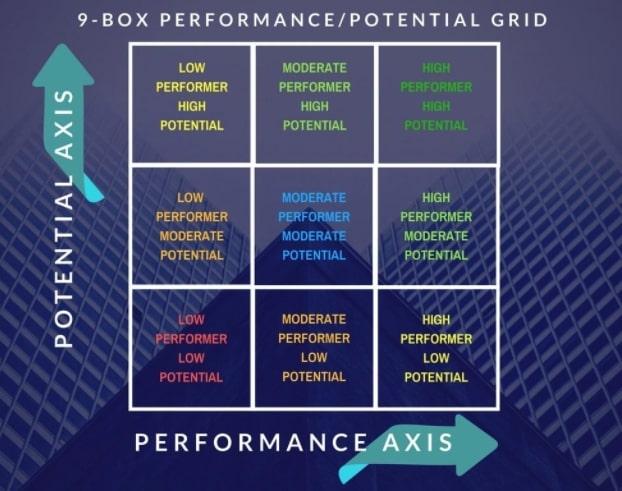
HR professionals and managers make use of a mix of tools to make their job more streamlined and efficient. These can consist of things like applicant management systems at the intake level. Tools like performance appraisal methods come into play later in the employee-employer relationship. In between the two, there is still a lot of room for your hiring efforts to become even more successful. The 9-box grid is a tool to help you assess individual employees in terms of current performance and growth potential. This can directly improve your succession planning, especially in conditions as uncertain as the times we are living through. Read on to find out more about the 9-box grid and how to use it.
What is the 9-Box Grid
The 9-box grid helps with the individual assessment of your workers. It focuses on evaluating both a worker’s current performance as well as their future potential to contribute to the business. The tool is a grid consisting of 9 boxes. The horizontal rows focus on a worker’s current performance. They will show whether a worker is performing below expectations, at par, or above and beyond. The vertical columns identify the future growth potential of the worker. Where the two metrics intersect offers you a reasonably fair assessment of where the worker currently stands, and what can be done to enhance their professional development.
Using The 9-Box Grid In Succession Planning
Succession planning is what allows long-lived businesses to stay relevant despite changing market conditions and shifts in consumer behavior. It refers to the process whereby businesses identify talent with strong leadership potential among the current workforce. Succession planning will obviously examine a worker’s current performance as well as the potential they possess to excel in a leadership role. While the specifics may vary from business to business, the 9-box grid is usually a helpful tool in identifying the current standing of your workforce. It will offer you an understanding of your current workforce as-is, helping you locate leaders and high-performers, as well as workers that may need to be reassigned, reclassified, or in worst cases, removed from the organization.
How To Use The Grid to Assess Performance
The horizontal rows indicate an employee’s current performance. This is usually segmented into three categories, namely low, moderate, and high. Performance appraisal information should give you enough to identify where a particular employee will land on the grid in terms of current performance. Low performers are workers that fail to meet their role’s requirements and targets. Moderate performers partially match what the job requires, and are usually better at managing individual targets. High performers meet all job requirements and frequently achieve above their expected targets.
The process will measure a worker's job’s roles and requirements as per the structure of your business. In addition, it also focuses on individual targets to assess individual capabilities and performance with more accuracy.
How To Use The Grid To Evaluate Potential
The vertical axis of the 9-box grid deals with a worker’s potential for growth as a possible business leader within your organization. The potential is divided into three broad categories: low, moderate, and high. Low growth potential employees are usually working to the best of their abilities, but cannot improve either because of a lack of capacity or motivation. Moderate growth potential indicates an employee can further grow and develop in their current role. A high-potential employee is a worker that is deserving of a promotion as soon as possible to better utilize their skills and capacity.
The Performance-Potential Intersection
This is where the grid really comes in handy. The 3x3 grid consists of 9 boxes. The horizontal rows and vertical columns indicate performance and potential respectively. Based on the last two sections, you should be able to plot a specific box that a particular employee lands in. The box in question will determine the next step, and what workforce management techniques to use from that point forward. The techniques will heavily depend on which of the nine boxes the worker falls on in the gird, namely:
- Bad hires.
- Up or Out grinders.
- Workhorses.
- Up or Out dilemmas.
- Core players.
- High performers.
- Dysfunctional geniuses.
- High potentials.
- Stars.
Also read about:
Why is it better to go with ISP License in India
All in 1 cleaning solutions
Actionable Strategies to Enhance Communication for your Construction Project








